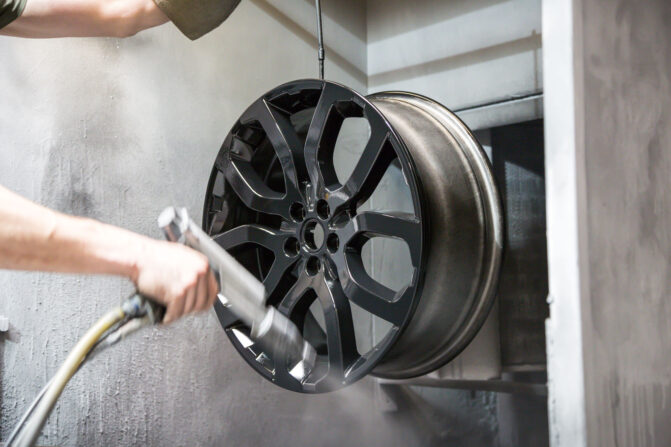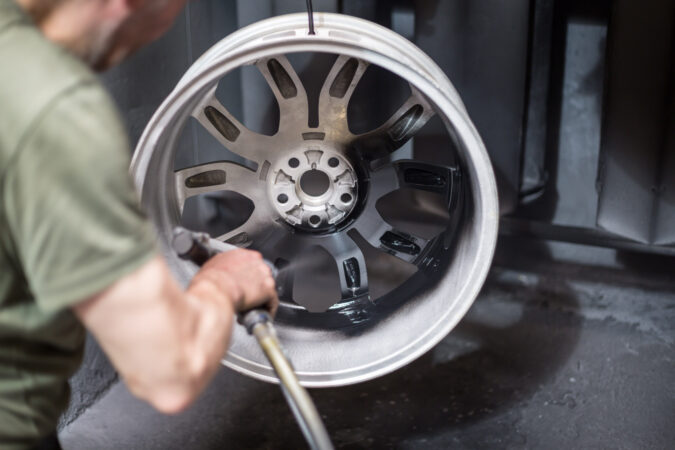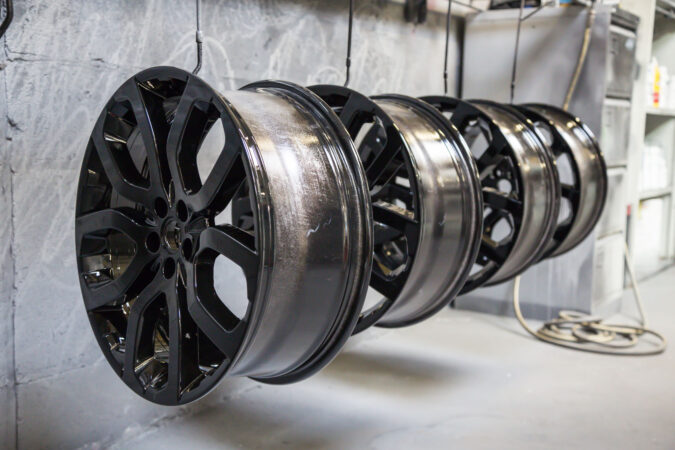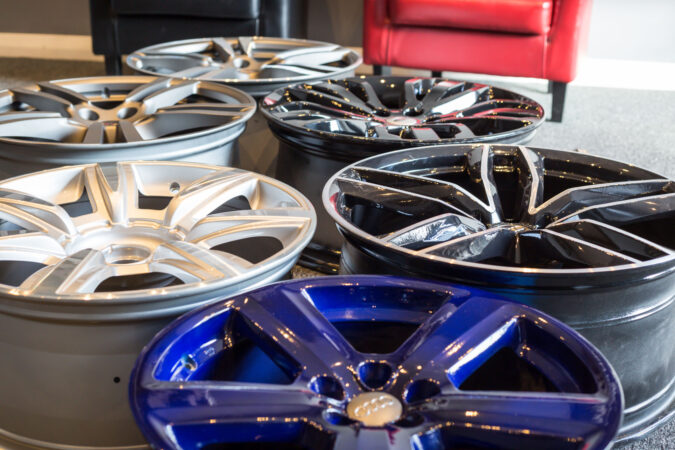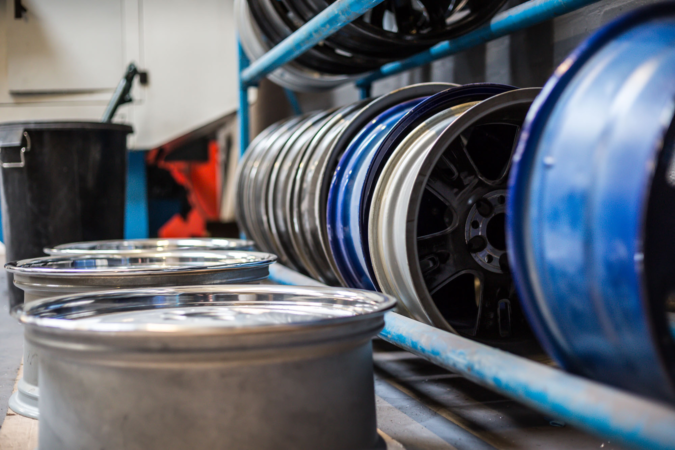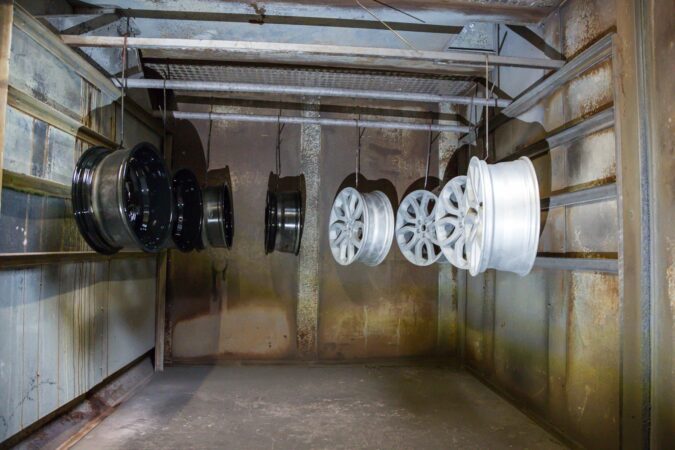Powder coated rims improve the appearance of your wheels while lowering the expense of your aesthetics. Rather than spending money on new custom rims when they become worn out, refinishing them with this process can help them seem brand new again.
Ground particles comprised of specific colors and resins are provided through powder coating. They get electrically charged as they are sprayed onto the refinishing surface, such as your wheel rims. That charge allows it to stick to the metal, and the wheels are then baked to merge the surfaces and create a firm cure.
As a result of this technique, you’ll get a high-quality, long-lasting surface with a consistent look.
Although there are other ways to improve your rims’ overall look and durability that require a new finish, you’ll want to consider the benefits and drawbacks of powder coated rims today.
- What Is Powder Coating?
- How Does It Function?
- What Can It Be Used For?
- Types Of Powder
- Steps In Powder Coating
- Pros And Cons?
- Can I Do It Myself?
- Why Is It Superior?
- Safety Tips
What Exactly Are Powder Coated Rims?
Powder coating was initially utilized in the 1940s when polymers or volatile organic chemicals (also known as macromolecules) were applied to a metallic surface in powder form. Due to the growing environmental movement in the 1960s, the industry flourished enormously. It leads to the electrostatic spray powder coating process, which uses electrically charged powder particles to cover a metal surface.
Electrostatic attraction attracts the powder to the metal surface. The metal is then placed in an oven once the particles have been bonded to it. The fact that paint may now be sprayed onto metallic surfaces without the need for polyurethane or volatile organic compounds (VOCs). It gives added strength as well as being a more environmentally responsible alternative to typical liquid paints and clear coat protection.
How Do Powder Coated Rims Function?
Volatile organic compounds can range from 5 to 380 grams per liter in liquid paints and varnishes, depending on the material. Powder coatings, on the other hand, constitute less than 2%. There is essentially no outgassing or waste because the identical amount of powder you apply ends up as the final coating after curing.
However, how can you apply any finish if you don’t have any liquid carriers? The fundamental idea of electrostatic attraction makes powder coating possible. Electrostatic attraction states that two particles having opposite electrical charges attract one another, while identical particles repel each other.
It acts in the same way that magnets do, except with fundamental charged particles instead of magnets. When you rub a balloon through your hair and hover over the shredded paper, you’ve already seen it happen.
Mechanics Of Powder Coated Rims
We need to look at the mechanics of the powder coating gun to understand how this idea applies to powder coated rims. In a hopper, the dry powder is kept. The powder is drawn through the barrel by a low-pressure air compressor, which then fires a tiny cloud from the nozzle.
If we just left it at that, the powder would bounce off the metal and fall to the ground or flow with the airflow. It wouldn’t even come close to covering the area. However, if opposite charges are introduced into the powder and coated parts, they will adhere to one another.
An emitter rod in the barrel’s core is attached to a high-voltage generator. The generator generates up to 100,000 volts, which creates an electric field around the rod’s tip, causing the surrounding air to be split into free-flowing positive ions and electrons. The powder takes up free electrons as it travels through the field and becomes negatively charged.
Because the coated component is always grounded, the metal’s electrons leave the surface positively charged. The negatively charged powder is drawn to the positively charged surface and adheres strongly, allowing us to cover the part in a thick layer.
After the part has been properly coated, it is placed in a curing oven to cure for 30 minutes at 400 degrees Fahrenheit. Heat causes the powder to melt together, resulting in a consistent coating with a strong attachment to the part.
In the same way, any powder that falls to the ground can be collected, cleaned, filtered, and reused. The method produces very little waste, making it an extraordinarily effective way to apply paint to the part.
What Can Powder Coated Rims Be Used For?
Because of the positive electrostatic attraction-based application to the material, powder coating is well-suited for metal items. It’s used in a wide range of metal products and objects. Powder coating is a type of finishing that is applied to daily home products. It is frequently used as a finish since it preserves the roughest and toughest materials.
They are frequently applied for large-scale restorations on cars and motorcycles, from the shell to integral yet delicate body elements. You can powder coat the following items:
- Trays for the pickup
- Powder coated rims and wheels
- Automobile frames and bodies
- Machine parts
- Panels and brackets
- Sway bars and springs
- Engine hoods
- Boxes
- Kickstands
- The grills on radiators
- Railings and racks
Powder Coated Rims
If you’ve opted to powder coat your parts or wheels, consider that different materials yield varied qualities in the end product. The majority of powders are available in various colors, finishes like gloss or matte, and even unique effects such as metallic flakes, transparent, and color blending effects, regardless of the chemistry.
Powder coated rims have limits, and they are generally more difficult to tailor than liquid paints. Except the most observant, everyone should be able to choose a finish they enjoy. The thermoplastic and thermoset chemical types of powder coating are the most common. Both have their own set of use cases and application processes.
Thermoset is the most often used. However, there are other more sorts of powder to be aware of in addition to those two procedures. Let’s have a look at them.
1. Powdered Polyester
Polyester powders are the most widely utilized, accounting for more than 60% of the market in the United States. They feature exceptional UV and chemical resistance, as well as good durability and an excellent finish.
The TGIC (Triglycidyl Isocyanurate) powder is the most prevalent variety. Because of their environmentally acceptable composition and decreased toxicity, TGIC-free powders are widely utilized throughout Europe. Higher-grade variations in this group include polyurethane and Super Durable Polyester powders, which provide improved corrosion resistance, durability, and longevity.
2. Powdered Fluoropolymer
The Cadillacs of powder coating are fluoropolymers (also known as Teflon, PTFE, and so forth). They excel at chemical, UV, and weather resistance and provide a consistent and long-lasting finish. Fluoropolymers are used to reduce friction in moving parts and to create non-stick surfaces.
3. Powdered Epoxy
Epoxy powders have excellent adhesion and chemical, salt, and corrosion resistance. They do, however, have low UV resistance, which is why they’re mostly used indoors or as primers for a separate top coat.
4. Powdered Acrylic
In the automotive sector, acrylic powders are extensively used for clear coatings. Acrylic powders are used to clear coat the majority of aluminum wheels. They cure into a clear, smooth surface that resists chipping and cracking and can withstand the hard circumstances and strong cleansers that wheels experience on a daily basis.
5. Powdered Silicone
Exhaust manifolds, turbos, heat shields, and other engine bay components all use silicone particles. When these are cured, they form a ceramic coating over the part, preventing heat from penetrating and injuring more delicate components. They are also resistant to all sorts of corrosion.
What Are The Steps In The Procedure?
The powder coated rims process in the automotive sector is divided into four general steps. Each substance requires a different powder coating. One of the most common misconceptions regarding powder coated rims is that it is a one-size-fits-all procedure. However, each material has its own powder coating definition that is used to achieve the best results.
Regardless, there are two types of polymers: thermoplastic and thermoset. The key difference between these two is the capacity to reverse or remove the coating. Thermoplastic coatings can be removed or melted, whereas thermoset coatings are permanent.
Step 1: Preparing The Surface Of The Product For Powder Coated Rims
After you’ve picked the correct powder material, you’ll need to do some prep work. The nature of prep work, like any other coating, can have a considerable impact on the overall application outcomes. Powder coaters who are skilled usually go through three steps of metal or plastic preparation.
Step 2: Blasting With Beads Or Abrasives
The first step is to remove any confinement from the coating substance. Bead or abrasive sandblasting is used to remove rust, mill waste, jetsam, and other exterior materials from metals. Small silica or sand particles are impacted at high gaseous tension in this cycle until the contaminants are entirely eliminated.
Step 3: Sharp Edges Grinning
The second step in the prep process (especially with wheels and powder coated rims) is to hand remove any sharp edges or burrs from the item to be coated. The powder accumulates or expands on sharp or articulated edges from time to time during the electrolysis stage of coating. The powder coated rims will smooth the product with a polishing or cutting wheel to ensure a smooth and even coating.
Step 4: Acetone Soaking Of The Product
After the object has been stripped down to its bare metal, the following step in the preparation process is to remove any excess crud or grime. Normally, the item is purified by soaking it in acetone or other chemical showers. The compound cleanser is removed during the final cleaning in a steam shower.
Step 5: Coating Application
The coating is applied with specialist equipment, starting with a splash gun or compacted air sprayer that electrostatically charges the powder that will be infused into a grounded metallic object.
Step 6: Curing The Coated Material
The use of a massive mechanical furnace or oven is required for the curing of powder coating. The product is frequently heated for 10 to 15 minutes at 350° to 375° F (175° to 190° C). After the initial process, the product is allowed to cool at ambient temperature for a few hours.
Benefits And Drawbacks Of Powder Coated Rims
Powder coating, like any other coating, has advantages and disadvantages. Keep all of the points in mind while powder painting your car’s rims or wheels.
Pros
1. Increased Resistance
Wheel rims are subjected to a lot of wear and tear. Corrosion, chipping, and flaking can be caused by exposure to the elements, as well as damage by road debris like stones and gravel. Powder coating provides a non-porous, more durable surface protection than traditional liquid paints, ensuring that your powder-coated rims can withstand even the most extreme road conditions.
2. Longevity
Once the powder coating is applied, it may be the hardest material on the planet. It’s a fantastic way to protect your material from scratches, dings, and dents. It isn’t the most durable or impenetrable item, though.
3. Economical
Powder coating is a product that can be used and reused because it does not include any chemical fluids. This means there are almost no waste materials, no VOCs, and no hazardous emissions after application.
4. Environmentally Friendly
It’s one of the most cost-effective ways to ensure mechanical parts because the procedure produces nearly no waste. Regardless, this is intended for industrial use. It may be more expensive than other DIY uses of paint protection products for DIYers.
5. Enhanced Coverage
Powder coating outperforms liquid paints in terms of coverage. Certain features of some intricately built wheel rims can be difficult to access with liquid paints. On the other hand, powder coating provides adequate coverage to even the most difficult-to-reach areas of the rim due to the electrostatic approach mixed with the curing procedure.
6. Adaptable To A Wide Range Of Materials
Powder coating is a versatile solution that works well with various wheel materials. Most wheels are made of steel or aluminum alloy, and a powder coating is ideal for these materials. Although powder coat will not adhere to chrome, it can be removed prior to application. Remember that you can have your car or truck accessories powder coated before installing them in your vehicle.
7. Quick Application
You won’t have to wait long for most powder painting tasks. The curing process is swift, resulting in a firm, even surface without the need for air drying. If your wheels are greasy and marked up, the cleaning and preparation process will take some time, and preparation is critical in most projects. The majority of powder coating tasks are completed in a matter of hours.
Cons
1. It Isn’t A Top-Notch Coating
Powders are occasionally cross-contaminated in the installation area. When this happens, it might impact the coating’s quality, specifically the shading and look. As a result of this reality, it’s best to complete your work and collaborate with a competent powder coating expert.
2. Weight And Thickness
If weight conservation is important to you, powder coating isn’t the best option. It’s a bit on the heavy side and goes on thick. It also doesn’t make much of a difference. When finished, it usually has a rough texture.
3. It Is Not A Hydrophobic Environment
Some people believe that powder coating wheels are fantastic since it makes them easier to clean. That is a different myth. Because it’s thick, things like brake dust and road grime will attach to it in general. It is superior to non-protection items in several ways; nevertheless, there are better options if this is your goal.
4. Significant Investment Capital
While it is possible to learn how to powder coat, the initial costs for special gear, setup areas, and proper ventilation can go into millions of dollars. The type of your equipment will have an impact on the ultimate outcome.
5. Repairing Is Difficult
Powder coating is quite durable, yet it has a significant drawback. It can be a large effort to repair one of your wheels if it gets damaged and needs a touch-up. The wheel will need to be repainted in most circumstances, making wheel damage a pricey issue.
Can I Do Powder Coated Rims Myself, Or Should I Hire A Professional?
Go for it if you have the tools to do a DIY powder coating job. However, if you lack the necessary tools, supplies, or a basic understanding of the procedure, we advise you to defer important tasks until these concerns are rectified.
For a project like powder painting wheels, the start-up expenditures can range from $5000 to $25 000. On the other hand, local specialists can offer you amazing prices since they have years of experience, high-quality equipment, and the necessary staff to complete the project on time. Furthermore, discounts are frequently available when you replace all of your tires at once, so keep this in mind.
What Makes Powder Coated Rims Superior To Other Paints And Finishes?
- Powder coating contains no solvents and cures without emitting any volatile organic compounds (VOCs) into the atmosphere. While this may not seem like a big deal to you if you aren’t concerned about the environment, you should be aware that major cities, such as Montreal, take these issues seriously and impose strict regulations on businesses in this industry.
- Powder coatings are more durable, thicker, and more aesthetically pleasant than liquid paints and rubber coatings. This makes it possible to achieve flawless results even in the most lustrous coatings, which are known for producing “orange peel.”
- Powder coatings are more flexible, so they will perfect your wheels that are subjected to traffic impacts. These hits force the alloys to bend, resulting in chipping and peeling if the paint doesn’t attach properly or isn’t flexible enough.
- Hundreds of colors and finishes are available to pick from.
- Corrosion-resistant primers outperform solvent-based primers and can reach into tight spaces like subframes and other stamped steel suspension components.
Can The Powder Coated Rims Be Used For A Long Time?
A number of elements will determine the product’s lifetime. The quality of the preparation, the type of powder coating utilized, and the environment in which the product is exposed are all elements to consider. Powder coated rims can last up to 20 years; however, they may deteriorate faster owing to frequent use, UV exposure, and exposure to the elements.
The longevity of different coatings varies as well.
Coatings including fluoropolymers and urethanes, for example, can endure longer. They are better suitable for outdoor products because they can withstand severe environments. On the other hand, epoxy coatings may survive a long time indoors but degrade quickly once exposed to the elements.
Powder Coating Safety Procedures
Powder coating is the most eco-friendly method of painting a component. That doesn’t mean it’s not dangerous for you and the painter.
- Avoid inhaling or ingesting the powder. When consumed, it is hazardous, and if not handled appropriately, it poses a considerably greater risk to your health. A decent mask and eye protection are required. A complete face shield is recommended.
- For curing your parts, invest in a specialized electric oven. You can use any oven that fits your parts, including a toaster. However, you should never prepare meals in the same oven where your powders were cured. The poisonous fumes released by heating the granules will permanently taint the oven.
- Keep fires and sparks away from the raw powder. The substances are extremely flammable, and you may inadvertently start a massive fire, causing severe injury. You obviously don’t want to smoke near your powders, but you should also take extra steps to remove any ignition sources from the area when powder painting.
- Be cautious of electric shocks. While operating, avoid touching the emitter rod, powder, or part. Hold the gun with your bare hand to ground yourself, then triple-check the grounding wire to the part before you begin coating. Before putting your device away, touch the emitter rod to the ground to discharge any static energy.
Alternative To Powder Coating: Ceramic Coating
Powder coating is a technique used by a few people to protect their car wheels and rims, exhaust tips, and other exposed performance parts from salt, road grime, chemicals, dirt, and debris. A high-quality, easy-to-apply process such as a DIY ceramic coating should be considered if this is your goal.
Ceramic coatings are frequently considered to be required for clear-coated paint. However, this is another misconception comparable to the one about powder coating only being used on metal. Armor Shield IX ceramic coatings can be used on alloy, magnesium, steel, and ceramic wheels. They’re also suitable for chrome and vinyl-wrapped surfaces.
Powder Coating Facts:
- Powder coating was developed as a surface protectant for industrial and military applications in the 1940s.
- Powder coating was initially applied using a “flame-sprayed” process.
- The liquid-bed dipping method was developed by Dr. Erwin Gemmer in the 1950s, which was followed by the electro-static application method developed by Pieter de Lange in 1960.
- Powder coating is used in the automotive, food and beverage, fire safety, and outdoor furniture industries.
- Powder coating is environmentally friendly as it does not contain harmful chemicals and is not high in VOCs.
- Proper prep work is essential for powder coating, including surface stripping, cleaning, and preparation, colored powder coating application, the first round of baking, cooling, clear coating application, the second round of baking, and final cool-down.
- Powder coating is popular for off-road racing vehicles, as it protects surfaces from environmental elements and can be sprayed in any color and finish.
- Two types of powder coating media are commonly used: thermoset and thermoplastic.
- The average cost of a powder coating job for a set of aluminum alloy wheels is around $400-$500.
- Powder coating is durable, inexpensive, and has a low environmental impact but lacks hydrophobic properties and quality control may vary among installers.
Powder Coated Rims, Final Verdict:
Since its first usage in the 1940s, powder coating has advanced significantly. While powder coatings are excellent for fastening modern hardware, the introduction of DIY ceramic coatings has introduced a superior alternative to powder coating on performance goods such as custom wheels.
Powder coated rims include putting a powder coating to the wheel trim and curing it at high temperatures until it hardens into a durable, uniform finish. The powder can be clear or colored with various colors, and it lasts far longer than a basic paint job. When compared to the cost of constantly having to patch scratches and restore the wheel’s luster, the cost of having your alloy wheels professionally powder coated is well worth it.

